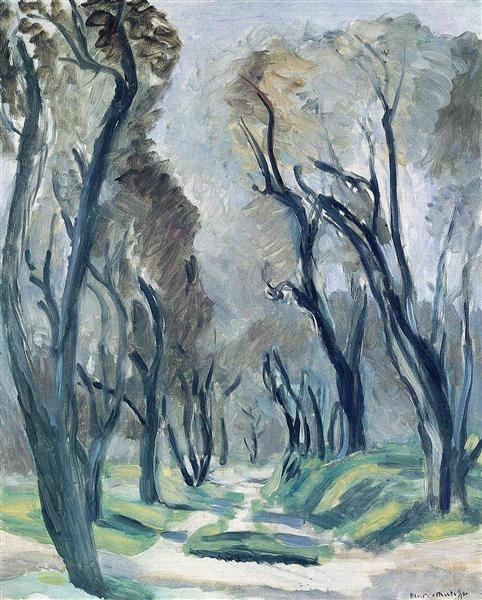Description
The painting "Avenue of Olive Trees" by Henri Matisse, dated 1952, is a work that encapsulates the essence of 20th-century art, vibrant in color and life, and at the same time, profoundly meditative in its simplicity. Matisse, one of the pillars of Fauvism, invites us to stroll through an avenue imbued with the calm and serenity that only centuries-old olive trees can provide. In this work, the artist explores, through his peculiar style, a communion between nature and human perception.
The composition of "Avenue of Olive Trees" is characterized by its organized structure, almost delineated in horizontal segments, which guide the viewer's gaze from the foreground to the horizon. The perspective is simple but effective, reflecting Matisse's ability to transform an ordinary landscape into a visual odyssey. The avenue is presented delineated by robust trees, whose winding trunks and exuberant foliage overflow with contained energy. The olive trees, represented with a mix of intense green and light tones, suggest a lasting vitality that transcends the canvas.
The use of color in this piece is particularly noteworthy. True to his style, Matisse employs an exuberant but not overloaded palette. The vibrant colors, characteristic of his work, are refined and harmonized. The blue of the sky invites contemplation, counterpointing with the earthy tones of the path and the subtle shades of olive green. The light, always a central element in his works, seems to insinuate itself through the foliage, creating a dance of shadows and reflections that give depth and dynamism to the scene.
Unlike other compositions by Matisse, "Avenue of Olive Trees" does not focus on the human figure, which is notable given the frequent presence of people and human forms in his paintings. Here, the trees themselves take center stage, almost endowed with their own personalities, narrating stories of ancient times through their robust branches and evergreen leaves. It is a celebration of nature in its purest form, a testament to the intimate connection Matisse felt towards the natural environment.
The choice of olive trees is no coincidence. These trees, which in many cultures symbolize peace and eternity, can also be seen as a metaphor for Matisse's own art: immortal, resilient, and always flourishing. As in many of his other works, Matisse manages to transform the everyday into an almost spiritual experience, leading the viewer to a state of serene reflection.
If we compare "Avenue of Olive Trees" with other works from the same period, such as "Interior with Flowers" or "Woman with Hat," we observe the evolution of his artistic quest for a synthesis between form and color. In all these works, Matisse reiterates his mastery in combining apparent simplicity with underlying complexity, using color as a vehicle to convey emotions and states of mind.
"Avenue of Olive Trees" should be seen not only as a representation of a Mediterranean landscape but as a meditation on the enduring nature of art and nature. In each brushstroke, one feels the almost mystical touch of an artist who understood, like few others, the heartbeat of the natural world and its reflection in the human soul. Henri Matisse, through this work, reminds us that even in the apparent simplicity of an avenue of olive trees, there lies a profound depth waiting to be discovered.
Thus, "Avenue of Olive Trees" rests like a pictorial jewel, a whisper of tranquility and perpetual beauty, worthy of an attentive observer who seeks, beyond the colors, the very essence of life captured in each stroke of Matisse.

